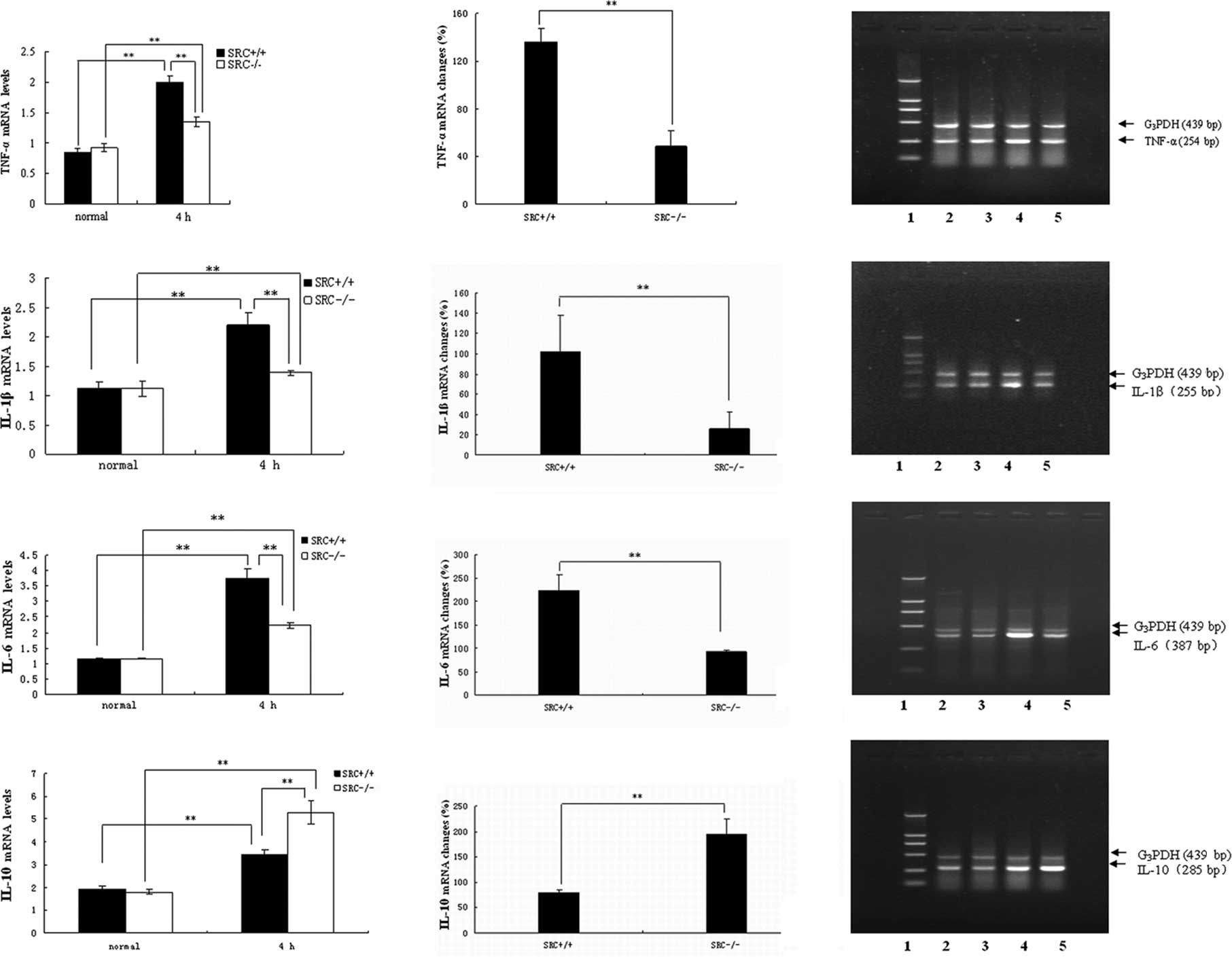Steroid receptor coactivator-3 differentially regulates the inflammatory response in peritoneal macrophages
- Authors:
- Jun Li
- Ying-Hai Liu
- Shan Ou
- Xue-Mei Dai
- Jun-Ping Wang
- Yong-Ping Su
-
View Affiliations
Affiliations: Department of Anesthesia, General Hospital of Chengdu Military Command Area, Chengdu, Sichuan 610083, P.R. China, Institute of Combined Injury of PLA, State Key Laboratory of Trauma, Burn and Combined Injury, Third Military Medical University, Chongqing 400038, P.R. China
- Published online on: January 12, 2012 https://doi.org/10.3892/mmr.2012.750
-
Pages:
1099-1105
Metrics:
Total
Views: 0 (Spandidos Publications: | PMC Statistics:
)
Metrics:
Total PDF Downloads: 0 (Spandidos Publications: | PMC Statistics:
)
This article is mentioned in:
Abstract
Steroid receptor coactivator-3 (SRC-3) is a transcriptional coactivator that plays an important role in the regulation of cytokine mRNA translation. In the present study, SCR-3 gene knockout mice were used to study the effects of SCR-3 on the regulation of the inflammatory response in peritoneal macrophages induced by lipopolysaccharides (LPS). Peritoneal macrophages (PMs) of SRC-3-/- mice showed a decrease in the release of TNF-α, IL-1β and IL-6, and an increase in the release of IL-10. Furthermore, results of RT-PCR also showed that levels of TNF-α, IL-1β and IL-6 mRNA expression were significantly lower, while the level of IL-10 mRNA expression was higher in the SRC-3-/- mice, compared to those of wild-type mice, following treatment with LPS (p﹤0.01). In addition, western blotting revealed that: i) the extent of reduction of the glucocorticoid receptor in PMs from SRC-3-/- mice was significantly lower than that in wild-type mice (p﹤0.01); ii) the extent of increase of AP-1 in PMS from SRC-3-/- mice was significantly lower than that in wild-type mice (p﹤0.01); iii) the extent of increase of NF-κB p65 in PMs from SRC-3-/- mice was significantly higher than that in wild-type mice (p﹤0.01). Collectively, our studies revealed that SRC-3 may play a key role in the maintenance of innate immunity. Furthermore, absence of the SRC-3 protein may result in the partial loss of inflammation and phagocytosis barrier function, including suppression of LPS-induced transcriptional activity, release of TNF-α, IL-1β and IL-6, and obstruction of the function of phagocytes and elimination of bacteria, as well as their production.
View References
|
1
|
JC WebsterRH OakleyCM JewellJA
CidlowskiProinflammatory cytokines regulate human glucocorticoid
receptor gene expression and lead to the accumulation of the
dominant negative beta isoform: a mechanism for the generation of
glucocorticoid resistanceProc Natl Acad Sci
USA9868656870200110.1073/pnas.121455098
|
|
2
|
A GoeckeJ GuerreroGlucocorticoid receptor
beta in acute and chronic inflammatory conditions: clinical
implicationsImmunobiology2118596200610.1016/j.imbio.2005.11.00216446173
|
|
3
|
L LiaoSQ KuangY YuanSM GonzalezBW
O'MalleyJ XuMolecular structure and biological function of the
cancer-amplified nuclear receptor coactivator SRC-3/AIB1J Steroid
Biochem Mol Biol83314200210.1016/S0960-0760(02)00254-612650696
|
|
4
|
O GojisB RudrarajuC AlifrangisJ KrellP
LibalovaC PalmieriThe role of steroid receptor coactivator-3
(SRC-3) in human malignant diseaseEur J Surg
Oncol36224229201010.1016/j.ejso.2009.08.00219716257
|
|
5
|
JP LydonBW O'MalleyMinireview: steroid
receptor coactivator-3: a multifarious coregulator in mammary gland
metastasisEndocrinology1521925201110.1210/en.2010-101221047941
|
|
6
|
I KuriharaH ShibataT SuzukiTranscriptional
regulation of steroid receptor coactivator-1 (SRC-1) in
glucocorticoid actionEndocr
Res2610331038200010.3109/0743580000904863511196413
|
|
7
|
H IwasakaT NoguchiTh1/Th2 balance in
systemic inflammatory response syndrome
(SIRS)Nippon-Rinsho62223722432004(In Japanese).
|
|
8
|
KP RumbaughJA ColmerJA GriswoldAN
HamoodThe effects of infection of thermal injury by Pseudomonas
aeruginosa PAO1 on the murine cytokine
responseCytokine16160168200110.1006/cyto.2001.096011792126
|
|
9
|
A PariharMS PariharS MilnerS BhatOxidative
stress and anti-oxidative mobilization in burn
injuryBurns34617200810.1016/j.burns.2007.04.00917905515
|
|
10
|
J LiYP SuHN LiuSF LouYS HuangJX JiangJP
WangDiazepam-ketamine inhibits 3 kinds of serum inflammatory
cytokines during the early stage in burned miceActa Academiae
Medicinae Militaris Tertiae261142004
|
|
11
|
MG SchwachaMacrophages and post-burn
immune
dysfunctionBurns29114200310.1016/S0305-4179(02)00187-012543039
|
|
12
|
PJ MackrellJM DalyJR MestreElevated
expression of cyclooxygenase-2 contributes to immune dysfunction in
a murine model of
traumaSurgery130826833200110.1067/msy.2001.11666911685192
|
|
13
|
EA DeitchMultiple organ failure.
Pathophysiology and potential future therapyAnn
Surg216117134199210.1097/00000658-199208000-000021503516
|
|
14
|
ZY DuYP SuBreeding, reproducing and
identifying SRC-3 knock-out miceActa Academiae Medicinae Militaris
Tertiae273733752005
|
|
15
|
DP SesterA TrieuK BrionLPS regulates a set
of genes in primary murine macrophages by antagonising CSF-1
actionImmunobiology21097107200510.1016/j.imbio.2005.05.00416164016
|
|
16
|
C GerardC BruynsA MarchantInterleukin 10
reduces the release of tumor necrosis factor and prevents lethality
in experimental endotoxemiaJ Exp
Med177547550199310.1084/jem.177.2.5478426124
|
|
17
|
N AuphanJA DiDonatoC
RosetteImmunosuppression by glucocorticoids: inhibition of NF-kappa
B activity through induction of I kappa B
synthesisScience270286290199510.1126/science.270.5234.2867569976
|
|
18
|
C RiccardiMG CifoneG
MiglioratiGlucocorticoid hormone-induced modulation of gene
expression and regulation of T-cell death: role of GITR and GILZ,
two dexamethasone-induced genesCell Death
Differ611821189199910.1038/sj.cdd.440060910637434
|
|
19
|
RI ScheinmanPC CogswellAK LofquistAS
Baldwin JrRole of transcriptional activation of I kappa B alpha in
mediation of immunosuppression by
glucocorticoidsScience270283286199510.1126/science.270.5234.2837569975
|
|
20
|
S OgawaJ LozachC BennerMolecular
determinants of crosstalk between nuclear receptors and toll-like
receptorsCell122707721200510.1016/j.cell.2005.06.02916143103
|
|
21
|
A WullaertRole of NF-kappaB activation in
intestinal immune homeostasisInt J Med
Microbiol3004956201010.1016/j.ijmm.2009.08.00719781989
|
|
22
|
L CaradonnaML MastronardiT
MagroneBiological and clinical significance of endotoxemia in the
course of hepatitis C virus infectionCurr Pharm
Des89951005200210.2174/138161202460698311945146
|
|
23
|
S WerbajhI NojekR LanzMA CostasRAC-3 is a
NF-kappaB coactivatorFEBS
Lett485195199200010.1016/S0014-5793(00)02223-711094166
|
|
24
|
CJ LoHG CryerM FuFR LoRegulation of
macrophage eicosanoid generation is dependent on nuclear factor
kappaBJ Trauma451923199810.1097/00005373-199807000-000049680006
|
|
25
|
C ChenYH ChenWW LinInvolvement of p38
mitogen-activated protein kinase in lipopolysaccharide-induced iNOS
and COX-2 expression in J774
macrophagesImmunology97124129199910.1046/j.1365-2567.1999.00747.x10447723
|
|
26
|
LH SigalBasic science for the clinician
43: the mitogen-activated protein kinase family in inflammatory
signalingJ Clin
Rheumatol139699200710.1097/01.rhu.0000260657.59520.4817414541
|












